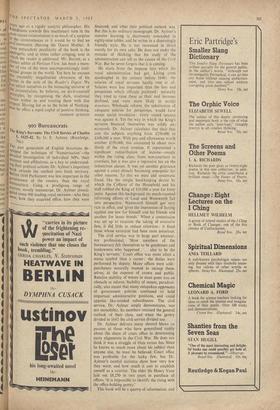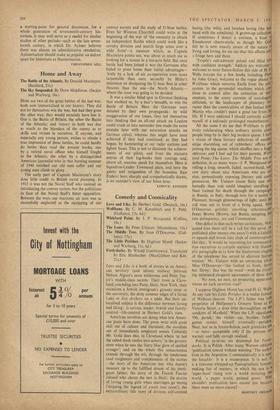900 Bureaucrats
MS past generation of English historians de- ,veloped the technique of 'Namierisation'—the "tailed investigation of individual MPs, their interests and affiliations, as a key to understand- 12111 dieir political actions. Dr. Aylmes important rnk extends the method into fresr'h territory. Before 1640 Parliament was less important in the government of the country than the royal bureaucracy. Using a prodigious range of SOurces, mostly manuscript, Dr. Aylmer investi- gated some 900 leading royal servants—who they were, how they acquired office, how they were financed, and what their political outlook was. But this is no ordinary monograph. Dr. Aylmer's massive learning is decorously \ concealed in eighty-nine tables, and he writes in a disarmingly friendly style. He is not interested in detail merely for its own sake. He does not make the mistake of thinking that his study of the administration can tell us the causes of the Civil War. But he never forgets that it is coming.
He starts from the impasse into which the royal administration had got. Living costs quadrupled in the century before 1640: the salaries of royal servants hardly rose at all. Salaries were less important than the fees and perquisites which officials pocketed: naturally they tried to raise these as their real incomes declined, and were more likely to accept douceurs. Wholesale reform, the substitution of adequate salaries for perquisites, would have meant social revolution: every vested interest was against it. Yet the way in which the King's servants financed themselves was wildly un- economic. Dr. Aylmer calculates that their fees cost the subjects anything from £250,000 to £400,000 a year. With pay and allowances worth another £350,000, this amounted to about two- thirds of the royal revenue, It represented a significant .redistribution of income—mostly within the ruling class, from non-courtiers to courtiers, but it was also a regressive tax on the industrious classes. It was yet another grievance against a court already becoming unpopular for other reasons, To this we must add systematic fraud, like the simple bookkeeping device by which the Cofferer of the Household and his staff robbed the King of £10,000 a year for forty years. Against this background the much-vaunted reforming efforts of Laud and Wentworth fall into perspective. Wentworth himself got very rich in office, and 'gives the impression of having applied one law for himself and his friends and another for lesser breeds.' When a commission was set up to examine the taking of excessive fees, it did little to reduce extortion: it fined those whose extortion had been most notorious.
The civil service was in large part amateur, not professional. 'Most members of the bureaucracy felt themselves to be gentlemen and landowners who happened . . . also to be the King's servants.' Court office was more often a status symbol than a career: the duties were performed by deputy. Many offices were sold: purchasers naturally wanted to recoup them- selves, at the expense of crown and public. Relative stability of tenure in most posts was an obstacle to reform. Stability of tenure, paradoxi- cally, also meant that many outspoken opponents of government policies continued to hold important administrative positions, and could appoint like-minded subordinates. The civil service, Dr. Aylmer amply demonstrates, was not monolithic. Its members retained the general outlook of their class, and when the gentry divided in 1642 the civil service divided too.
Dr. Aylmer delivers many shrewd blows en passant at those who have generalised rashly about the share of court office in determining party alignments in the Civil War. He does not think it was a struggle of Outs versus ins. Since he knows so much more about his subject than anyone else, he must be believed. Court office was profitable for the lucky few, but Dr. Aylmer's careful statistics show how very few they were; and how much it cost to establish oneself as a courtier. The elder Sir Henry Vane laid out £8,250 in two years in purchase of offices. 'It is impossible to identify the rising with the office-holding gentry.'
This book will be a quarry of information, and
a starting-point for general discussion, for a whole generation of seventeenth-century his- torians. It may well serve as a model for similar studies of other periods—such as the late seven- teenth century, in which Dr. Aylmer believes there was almost an administrative revolution. Aylmerisation should make as popular an indoor sport for historians as Namierisation.
CHRISTOPHER HILL







































 Previous page
Previous page